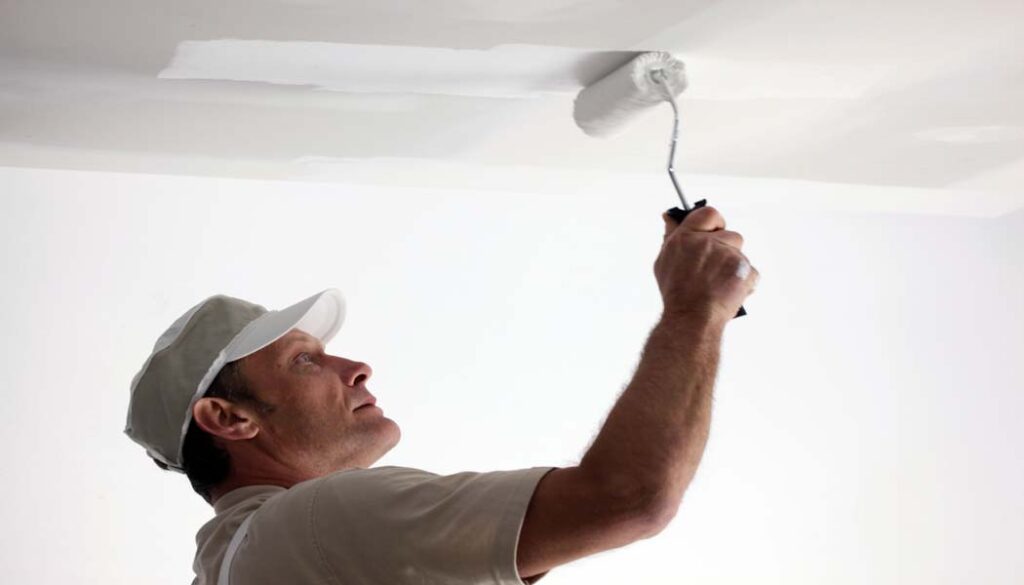
Can Primer Be Used as Ceiling Paint?
If you’re looking for a quick and cost-effective way to give your ceilings a fresh coat of paint, you might be wondering – can primer be used as ceiling paint?
While primer can be used as a substitute for ceiling paint in certain situations, it’s not recommended for most cases. Primer isn’t formulated to withstand the wear and tear that comes with the normal use of a ceiling.

However, before you break out the primer, there are a few things you need to consider. In this article, we’ll explore whether primer can be used as ceiling paint, and what factors you should keep in mind when deciding whether or not to use it. So, let’s dive in and find out if the primer is a suitable alternative to ceiling paint!
Primer vs. Ceiling Paint
There are a few key differences between primer and ceiling paint. Take a look.
Purpose:
Primer is used to prepare a surface for painting, while ceiling paint is formulated specifically for use on ceilings.
Finish:
Primer is typically available in a variety of finishes, while ceiling paint is formulated with a flat finish that helps to hide imperfections and doesn’t reflect light.
Coverage:
Primers are typically thinner and more porous than paint, allowing them to penetrate the surface and create a strong bond with the paint. Ceiling paints are formulated to provide good coverage and protection to the surface.
Durability:
While primers can provide some protection to the surface, they’re not designed to withstand wear and tear on their own. Ceiling paints, on the other hand, are formulated to be durable and long-lasting, even when exposed to moisture, heat, and other environmental factors.
Application:
Primers are typically used as a first coat before applying paint, while ceiling paints can be used as a single coat to achieve a smooth and even finish.
Now choose the right product for your specific painting project and achieve the best possible result by understanding the differences between primer and ceiling paint.
Can Primer be used as Ceiling Paint?
Primer is designed to create a smooth surface and help paint adhere better, so it seems like a logical solution to use primer as ceiling paint. But if you want to achieve a smooth, even finish and protect your ceiling from wear and tear, it’s best to use a paint specifically designed for ceilings.
If you’re painting a ceiling that has never been painted before, using a primer first can help create a consistent surface that the paint can adhere to. However, if you’re painting over an existing ceiling, using primer instead of ceiling paint can be a mistake. Primers are typically thinner and more porous than paint, so they won’t provide the same level of coverage and protection as a paint specifically designed for ceilings.
Additionally, primers are typically available in a variety of finishes, while ceiling paint is formulated with a flat finish that helps to hide imperfections and doesn’t reflect light. If you use a primer with a glossy or semi-glossy finish, you may end up with a shiny, reflective surface that draws attention to any imperfections in the ceiling.
Why Use Primer on Ceiling?
Know a few reasons why you might want to use primer on a ceiling:
Stain Blocking:
If your ceiling has water stains or other discolorations, using a primer can help to block them from bleeding through the new paint. Many primers are formulated specifically for stain blocking, so they can be especially useful in these situations.
Surface Preparation:
If your ceiling has never been painted before, or if it has an uneven texture or other imperfections, using a primer can help create a smooth and consistent surface that the paint can adhere to. Primers are designed to penetrate the surface and create a strong bond with the paint, ensuring a long-lasting finish.
Adhesion:
Even if your ceiling has been painted before, using a primer can help improve the adhesion of the new paint. This is especially important if you’re using a different type of paint than what was previously used, as different paints can have different adhesion properties.
Time Savings:
Using a primer can help to reduce the number of coats of paint you need to apply to achieve good coverage. Because primers are designed to penetrate the surface and create a strong bond with the paint, they can help the paint adhere better and provide better coverage with fewer coats.
How to Priming Your Ceiling
here are the step-by-step instructions on how to prime your ceiling:
Materials you’ll need:
- Primer
- Paint roller
- Paint tray
- Paintbrush
- Painters tape
- Drop cloth
Step 1: Prepare the room
Remove any furniture, decorations, or fixtures from the room. Cover the floor and any remaining items with a drop cloth to protect them from paint splatters.
Step 2: Clean the ceiling
Use a broom or vacuum with a brush attachment to remove any dust or cobwebs from the ceiling. Clean any stains or marks with a damp cloth or sponge, and allow the ceiling to dry completely before continuing.
Step 3: Apply painter’s tape
Use painter’s tape to mask off the edges of the ceiling and any areas you want to protect from the primer.
Step 4: Mix the primer
Stir the primer thoroughly with a paint stirrer to ensure that the pigment is evenly distributed.
Step 5: Pour the primer
Pour the primer into a paint tray and load the roller evenly.
Step 6: Apply the primer
Starting at one corner of the ceiling, use the roller to apply the primer in long, even strokes. Work in small sections, rolling the primer onto the ceiling in a “W” pattern. Use a paintbrush to get into any hard-to-reach areas or corners.
Step 7: Allow the primer to dry
Follow the manufacturer’s instructions to determine how long to allow the primer to dry before applying paint. Typically, it will take a few hours.
Step 8: Inspect and touch up
Once the primer has dried, inspect the ceiling for any missed areas or imperfections. Use a paintbrush to touch up any areas as needed.
Step 9: Clean up
Clean your tools with soap and water, and remove the painter’s tape from the ceiling.
That’s it! Following these steps should ensure a smooth and even primer coat on your ceiling, ready for paint.
Is Primer Better than Paint?
No, primer is not better than paint, but they serve different purposes. Primers are designed to prepare surfaces for paint by providing a smooth, even base and promoting adhesion.Paint, on the other hand, is formulated to provide color, durability, and protection to a surface.
While both are essential in the painting process, they have different properties and are not interchangeable. Using a quality primer before painting can help ensure a professional-looking finish, but it should not be used in place of paint.
Is Primer Cheaper than Paint?
In general, primer is cheaper than paint. Primers are usually priced lower than paints because they contain fewer pigments, which are the expensive ingredients that give the paint its color.
Additionally, primers often come in larger quantities than paint, so you get more products for the same price. However, the cost difference between primer and paint can vary depending on the brand, type, and quality of the product.
Is Primer Thicker than Paint?
Generally speaking, primer is not necessarily thicker than paint. The thickness of a primer or paint is typically determined by the type of paint, the manufacturer’s formulation, and the intended application method.
However, some types of primers, such as oil-based primers, may have a thicker consistency than some types of paints. This thicker consistency can help the primer adhere to the surface and provide a smooth, even base for the topcoat of paint. However, there is no inherent difference in thickness between primer and paint.
Final Words
Primer can be used as a base coat on a ceiling, it is not so good as a substitute for ceiling paint. Primers are designed to prepare surfaces for painting, whereas ceiling paints are specifically formulated to provide the right level of adhesion, coverage, and durability for a ceiling.
Attempting to use primer as ceiling paint may result in a suboptimal finish that is prone to peeling, cracking, or discoloration over time. It is best to invest in quality ceiling paint that is specifically designed to meet the demands of a ceiling surface.
